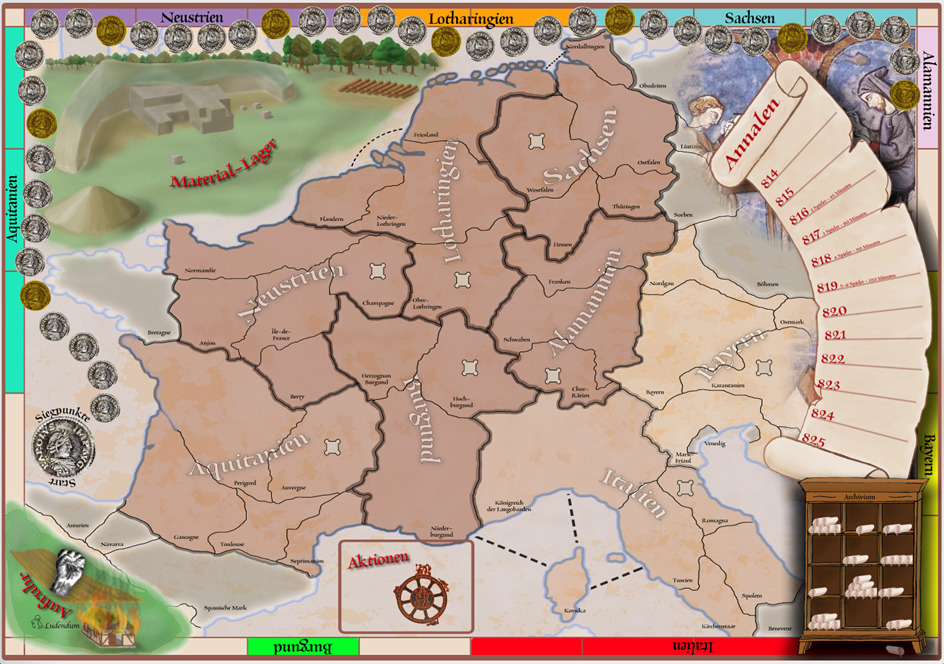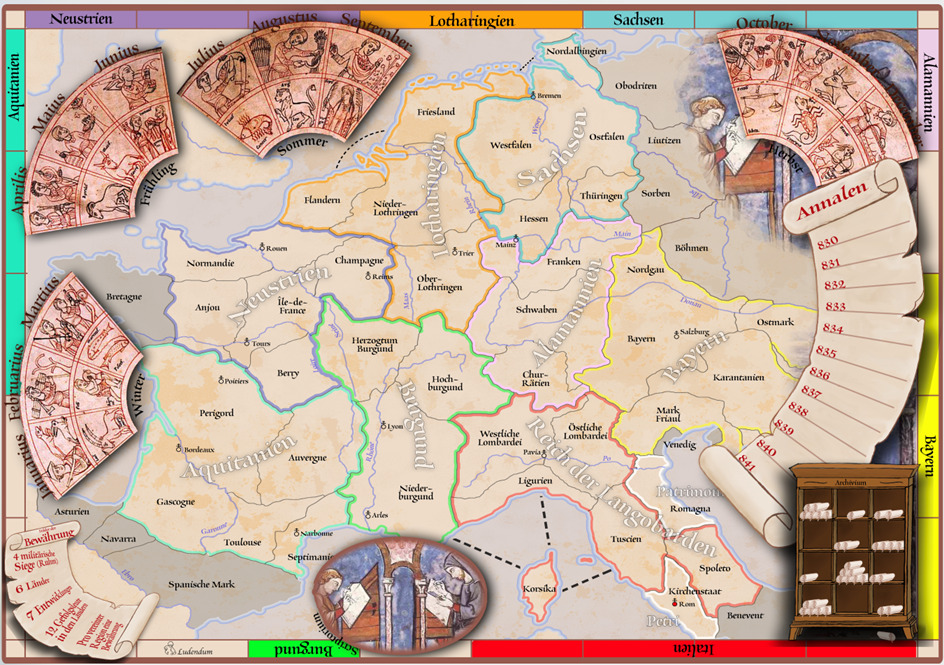
Designer Diary: How we made Carolingi
History teacher Sebastian Freudenberg describes his years-long journey to publishing his debut game Carolingi, in which players act as Charlemagne’s grandchildren fighting over his vast realm using a bag-based action selection system to control areas of the map, unite regions, develop their realms, attract followers and gain glory. Carolingi is the first game from Sea Cove Games, the joint publishing company launched last year by Peter Eggert, who created Eggertspiele in 1996, and Spielworxx’s Uli Blennemann. Carolingi is available for pre-order here.
I am a teacher of Latin and history. I like to conclude my classes at the end of the school year by having the students develop a game based on what they have learned. That’s what I did also in the summer of 2017, and I came up with the idea of developing a game myself.
My guiding thoughts were:
a) decision-making through worker placement and
b) what I call the planning dilemma.
This means an interdependent circle of your own goals and moves and the result of the moves of all game participants in total. In other words: You can want something, but what comes out of it is decided by the will of all, who act independently of each other. The best example of this is the well-known Diplomacy, where all players write down their moves in advance to then execute them together simultaneously.
The idea to place my game in a historical setting was obvious from the beginning – as all started from a history class. But somehow I didn’t dare, or was still so mechanism-oriented, that I thought I should try an abstract setting first.
As far as worker placement is concerned, the basic idea was the majority principle, i.e., collecting more cubes on action fields than the others. This was to strengthen influence in a territory, bid for control over resources, or achieve the unlocking of possible actions.
The tension between one’s own planning and limited predictability of the result was to be ensured by the move mechanism. A simple writing down of the bid amounts on the respective fields seemed too flat and too undynamic to me. So my first approach was to give three tokens from each player into a draw bag. Whoever drew a token had to use at least one of his or her cubes, but could also use all he or she had. The dilemma was that the round stopped as soon as everyone had drawn at least one token of their color. So you risked giving away your move if you didn’t put everything you had immediately in the first occasion. On the other hand, it was a disadvantage to set at the beginning, as the followers could then adjust to their decisions and create majorities much more targeted.
As far as the game board is concerned, there was a terrain divided into hexagons right at the beginning. Each player could place one or more stones on an area that he or she already controlled (majority of stones), or that bordered on such an area. If there were already stones of another player on this area, a majority had to be created there during the turn. In a subsequent phase, “Clarification” took place, a direct precursor of one of the two oldest actions of Carolingi, today present as the “Battle” tile. Unlike after the clarification, however, all stones of the victorious color were also removed into the stock except for one. An income phase then equipped the player for the next round according to the number of countries controlled with new stones. Another original action that made it to Carolingi and is now called “Equip Missi”.
At this point, the game was just a hobby, something I could tinker with. Yet, eventually, a desire emerged to share it with others, to play and improve it. And of course, there was also the thought – though only in my wildest dreams – of publishing the game. In fact, the game – which didn’t even had a name yet – had progressed to the point where I could present it at the Würfel und Zucker in Hamburg. A word must be said about the “WuZ,” as this location is known among enthusiasts. The store is an institution in Hamburg for everyone involved with games. It boasts a well-stocked game library and staff who can as quickly explain the latest game as they bring you a pizza and a cold beer. However, the heart and soul of the WuZ is Silke, the owner. I’ve never met anyone so informed about games and the gaming scene. Mention a specific mechanism, and she’s already pulled the corresponding game off the shelf: Absolutely astonishing!
Well, the WuZ hosts prototype days where everybody can come and present a new game. At one of these events in early 2018, someone curious provided another crucial idea to my game. He found my basic mechanism quite interesting and asked how I came up with it. I told him about my history lessons; he stood up, drank my tea and asked why not make it into an actual historical game? Then he left; I never saw him again. But his words encouraged me to finally set a historical context for my creation. Everything else fell into place: The board naturally became a map of Charlemagne’s empire – my favorite era that I’m most familiar with due to my academic work. Thus I knew exactly which atlases would provide accurate early medieval boundaries; you can clearly see that this map closely resembles today’s Carolingi map by comparison. By now, even our unnamed project had earned its working title: 814 – marking Charlemagne’s year of death.

The picture quickly expanded: The economic development of the countries could now be depicted as well as the military peculiarities of this era, political processes as well as trade. Accordingly, material was added: development cards that gradually expanded the range of actions in the sense of deck building, such as in the military field, the development from the fortification, to charisma, to the army ban. Since I am not a graphic designer, I had to steal from the internet (of course only for the prototype and temporarily) or photoshop symbol images. So the period detail was not always correct, for example when the Charisma card shows a picture from the high (almost late) medieval Codex Manesse.


A ranking list showed who had risen, and how far. Accordingly, one could have more and more of the development cards in the deck. However, the costs for the followers also increased.

So far, so conventional. Something new I thought about at that time with the “Hoftag”: To be able to talk about what happened in the game and make corresponding agreements, one had to put some of their precious stones on the color with which one wanted to speak. Here it shows how important it was for me from the beginning that the participants related to each other: One should not play next to each other, but sometimes against each other, sometimes with each other, but always related to each other.
Half a year later, from August 2018, the changes came fast. And that was no wonder, because Christoph Cantzler entered the stage. From now on, the game was no longer just a hobby of one person, but teamwork with the goal of publication. So Christoph systematically questioned all rules and mechanisms for their necessity. Handling became an important keyword. The roles were quickly assigned: I continued to work on the game as before and even more intensively, then presented the results to Christoph, and he discarded most of it, but always pointed out improvements that I should incorporate into the prototypes as homework for next time.
Another role distribution between Christoph and me was established and is still effective today: Christoph looked at simplicity in material, mechanism, and handling. I had to secure historical authenticity. Quite a balancing act! We managed this because each of us appreciated the competence of the other in his area. Nevertheless, it should take years until we had a game with Carolingi that is both: Very fast and intuitively playable, but also historically authentic. But back to the development of the mechanisms.
The chaos stones became more prominent, and much more aggressive than later in Carolingi: A chaos stone came to every country that was not ruled by a Carolingian as well as to all adjacent fields! And it happened quickly that a country remained without rulership, because in the clarification phase all stones were cleared except for one, so that one chaos stone was enough to endanger the rulership over the country in the next year.

On the other hand, the development cards were dropped. Now it was only about countries and buildings. But now a marketplace for those buildings appeared as a playing field.

A few months later, the development stages were back in, but no longer via cards, but on a player display and reduced to the areas of city and trade as well as social cohesion.

The acting mechanism also received an update. In the meantime, it always had to be decided with dice who made the next move. Now we reverted to my old idea of the draw bag. A round was over when a player had drawn all five, and everyone had drawn at least one of their markers. Further, you could also collect points by either removing chaos stones, winning victories over other players, supporting others in their moves (or not!) fighting – that is, holding peace. An attempt to capture early medieval fields of action.
In addition, the range of construction options was limited when the number of chaos cubes on the board increased, i.e., decreased in the stock. I became more and more fascinated – and Christoph was happy to join in – with the idea of authentically linking mechanisms through very simple handling. In this case it meant that bids could only be made on building market stalls where at least one chaos stone had remained.

Furthermore, the sequence of rounds was streamlined and simplified. For this, the chaos cubes developed even more life of their own. A chaos agent had to manage the cubes. It was always the player who was most behind. An uphill mechanism that I still find interesting, but shifted the game to a meta-level among the participants, because now as a leading player you had to be careful that no one was permanently behind and found his role in letting Carolingian rule descend into chaos. An interesting constellation in game theory. But Christoph and I realized that we didn’t want that. One should play his or her game and position themselves in roles as Carolingians towards each other.

Illustrations, or as I learned later, immersion, was important to me from the beginning. I tried to capture them in individual representations, but also fully develop game rules with every prototype which was aesthetically very satisfying but also insanely laborious. But 814 was my hobby – I spent every free second on it.


Until April 2019 further important changes occurred: The draw bag was replaced by cards which were shuffled and then worked off card by card where each player could place their cubes until everyone had at least one card lying before them. Unused cubes were “lost” for this round – a dilemma that stood at the beginning of the game.

However, country cards were introduced as a novelty – another opportunity to authentically capture Carolingian times because the history of the Frankish Empire is primarily a history of regional conflicts. A series of country cards were drawn and laid out and Carolingians had opportunity to lay stones on these cards. A card left empty received a chaos cube on the land itself and all the other neighbouring countries – an idea retained until today’s Carolingi.

Also new was the possibility to unlock new cards and thereby gain more followers. That created quite an exciting wave movement, since initially valuable cubes had to be withdrawn from your own cycle (uphill-mechanism), only then with much more force both new action possibilities as well as new resources became available (downhill-mechanism). The fact of the dependency of Carolingians from their followership emerged.
Until October 2019, several minor changes were made, tested, but most of them discarded. But among those ideas was the groundbreaking thought for Carolingi – the actions. There were Material, Building, Alliance, Revenue, Moving, Clarifying, Regions and Victory. Here, the later action tiles are partly already depicted, partly they can be guessed.


In addition, the innovative idea (at least I did not know the mechanism until then) was to provide the action cards with a unique number, so that a sequence of moves would result by itself when the simultaneously and secretly laid cards were revealed. So one was faced with the dilemma of not only choosing the action but also being able to estimate the order of moves at least approximately. I still find the idea exciting, but Christoph and I at last decided against it, firstly because of the large amount of cards that had to be printed for a game with up to 6 participants, but above all secondly because of a high random character – who drew which cards in which round. Because it could be that one drew “Alliance” five times, but not once “Moving”. This made a complex exchange mechanism necessary, which had high handling costs and slowed down the game.
But at least, the idea of actions was born, and soon came the next step, which brought 814 significantly closer to the final version of Carolingi: the action tiles. Here are the front sides of the boards, which still had the width of domino stones. If you look at the illustration more closely, clear steps towards Carolingi can already be seen, for example with “Strengthen Influence” and “Unfold Power”, two boards that later merged into “Influence”, or “Procure Material” and “Build”, which later became an option of the action “Develop”.

In December 2019, the time had come to present our game to Peter Eggert and then extensively test it with others. Under Corona conditions, that emerged just in this time, this was not easy. However, the combination of Photoshop and Zoom proved to be surprisingly helpful.

Looking at the gameplay of this version, the essential elements of Carolingi are already depicted: The laying of tiles and the random order of turns, which was then still determined by a throw into the lid of the game box. The throwing was to symbolize the hand of destiny. However, this had the consequence that the sequence of the turns and the following actions were recognizable – a strategic decision that was later abandoned in favor of that basic principle that we described above, as the interdependent circle of one’s own actions and the result of the actions of all game participants in total. It should not be clear during one’s own acting what others would do in the ongoing game and when. This principle has been criticized a lot in forums as “random”, but it is a very conscious decision for the authentic representation of premodern planning uncertainty, and makes up the essence of Carolingi. In fact, there is not a single random element in all of Carolingi, at least not in the sense that one is helplessly exposed to chaotic activity. Rather, it is always and again about risk management. I can secure my countries economically through developments, so that I don’t care when the hunger comes. And I can also lay down only one action instead of two, and the other board shows “No action”. So I can plan very precisely in which order my actions will appear. But I just can’t foresee what can’t be foreseen, namely what the other players will decide. And yet, as an increasingly experienced Carolingian, I can guess what my siblings are up to.
The game board was now almost Carolingi. However, it is noticeable that the victory points are still represented as a Kramer bar. The last step, the peace tile, had not yet been made. This cost us a lot of strength once again. Our chief tester Sven has done a great job here.

So in the first half of 2020, the victory conditions were added, as well as the simplified version for first-time players, the seasons as a storage for the action tiles and thus the four step rhythm of the round year, and finally the special mechanism of the peace tile.

It was a long way to Villingen in November 2021, where we were able to present our game to Uli Blennemann for the first time. Was the development completed with that? No. Even after that, slight changes were added again and again, such as with hunger, which had previously had a regional effect, but now relates to the entire Carolingian Empire. And in the future? There are numerous expansion ideas in the drawer, just waiting to be realized!
Carolingi cancelled its Gamefound campaign at the end of January, but raised more than €20,000 on German crowdfunding site Spieleschmiede and is now available for pre-order ahead of an expected release later this year.






